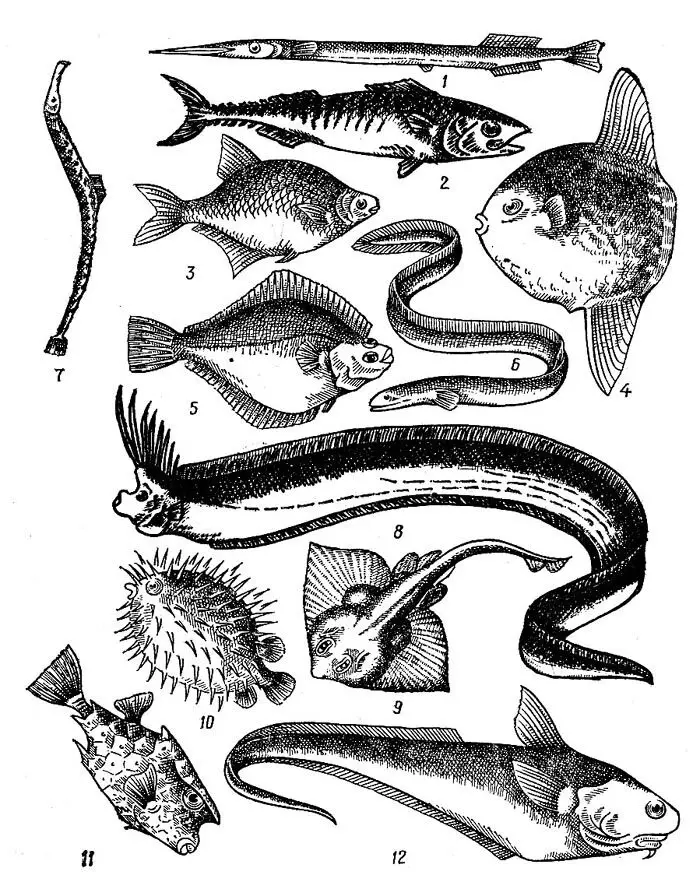Over the entire time of evolution in the aquatic environment, fish have developed a body shape that is ideal for smooth sliding, quick jerks, the development of high speed, and vice versa “hovering” in the aquatic environment. And all this – with minimal energy consumption.
These factors are ideally embodied in the smooth, slimy body of the fish, without a neck, with a pointed head. However, depending on the behavior and the specific habitat (water layer, current velocity, and other habitat conditions), the shape of the fish body can also be different.
By distinguishing the “structures” of the fish body, the aquarist will be able to imagine in which layers of water the fish acquired by him prefer to live, as well as the circulation of the aquatic environment of what intensity they need.
Differences in Fish Body Shape
In simplified terms, these differences are as follows.
Fish-swimmers, keeping in the upper and middle layers of water with a strong current, has an elongated torpedo or arrow-shaped body, with a flat back and a weakly expressed dorsal fin deflected back.
Fish that live in the same conditions, but in calm, stagnant water, have a laterally elongated body shape and more developed fins.
Living in an environment with “abundant underwater interior or vegetation”: driftwood, thickets of plants, rocks, and other fish, have a stocky body, often flattened from the sides, usually with large fins.
12 Fish Body Shape Types
The body shape of benthic fish is flat, with well-developed pectoral fins, which help the fish to move along the bottom. Experts identify 12 types of fish body shape:

1) Sagittal: pointed head, the same body height along the entire length, the dorsal fin is deflected back and located above the anal (imitation of “arrow plumage”). These are predators ( pikes, garfish ) living in the middle and upper layers of the water, not moving long distances, but developing high speeds and attacking their prey from ambush.
2) Torpedo (often confused with fusiform ): the head is pointed, the body is rounded, the tail is thin, and often has additional fins. These are fish that move long distances: mackerels, tuna, sharks.
3) Fusiform (the most common form of the body of fish): the head is slightly pointed, the body is compressed from the sides. These fish live in all layers of water, as well as in reservoirs of varying current intensity and with a variety of underwater landscapes.
4) Symmetrically laterally compressed body: the body is high, laterally compressed, and has a rather short length. Typical for the inhabitants of coral reefs, reservoirs with large thickets ( scalars ). Due to the peculiarities of the skeleton, these fish quickly maneuver among thickets or corals and escape from predators. More examples of fish with a symmetrically compressed laterally compressed body: sunflower (Zeus), moonfish (Mola mola L.), bream .
5) Body asymmetrically compressed from the sides: eyes are located on one side of the body. These are, first of all, sedentary fish living on the bottom: flounder (Pleulonectiformes) . Almost all of them swim on one side of the body, move with the help of long dorsal and anal fins.
6) Eel-like: elongated, rounded, with the shape of an oval in the cross section. The dorsal and anal fins are large, the caudal fins are small, and the pelvic fins are absent. These are bottom and bottom fish, wriggling moving: eels (Anguilliformes) .
7) Needle-shaped: elongated, hidden in the bony shell, imitates the sharp leaves of plants, in the thickets of which these fish hide. They do not move sideways, up and down movement occurs thanks to the dorsal fin: sea needles (Syngnathus) .
8) Ribbon-like: elongated, but in contrast to the eel-like shape, strongly compressed from the sides. This allows her to have a large area of contact with water and live in the middle layers of the water: saber fish (Trichiuridae), herring king (Regalecus) .
9) Dorsally flattened body: very flattened in the dorsal-abdominal region, usually has developed pectoral fins, eyes are located on one side of the body. These are sedentary bottom fish: many rays (Batomogrha), monkfish (Lophius piscatorius L.) .
10) Spherical: sedentary, swelling in case of danger, fish: ball fish (Sphaeroides), hedgehog fish (Diodon) .
11) Asterolepid (or box-like): fish are covered with a bony shell that rescues from predators. These are bottom fish, often inhabitants of coral reefs.
12) Macro-shaped: high in the front and tapering in the back, especially in the tail, with a large head and eyes. Deep-sea sedentary fish: grenadier (Macrurus), chimera (Chimaeriformes) .
However, there are also species that do not fall under any of these descriptions. Their body shape is a combination of several of the above options.